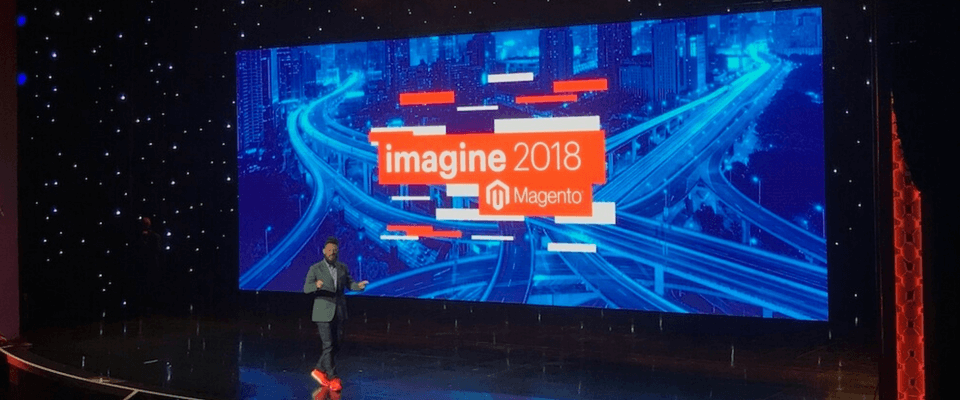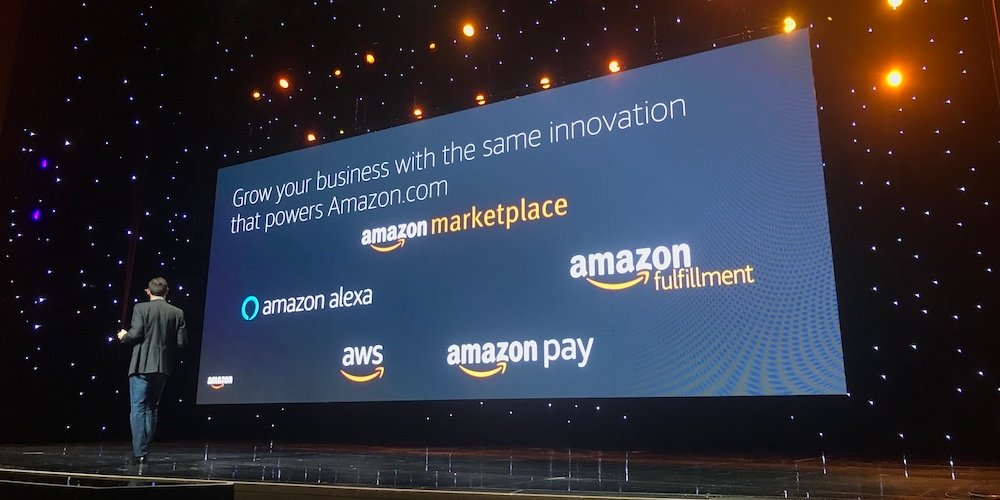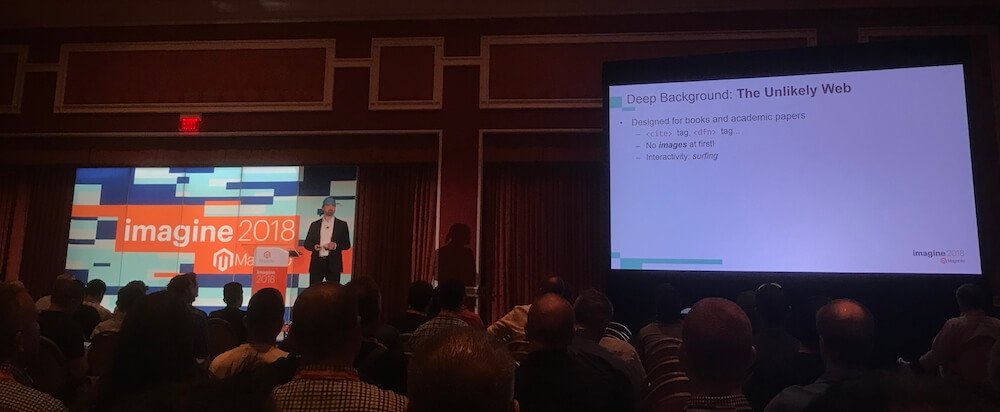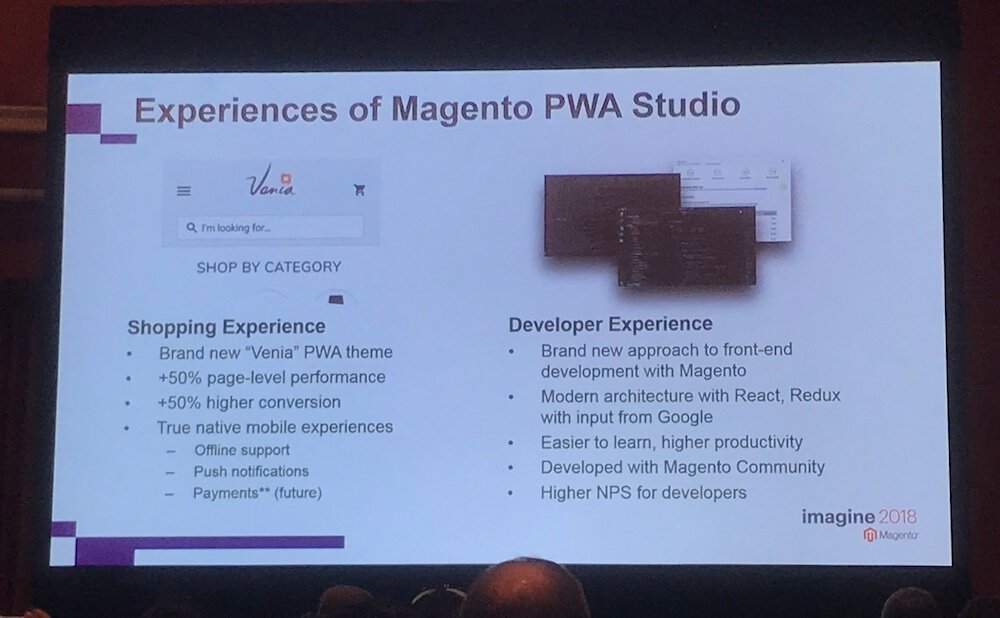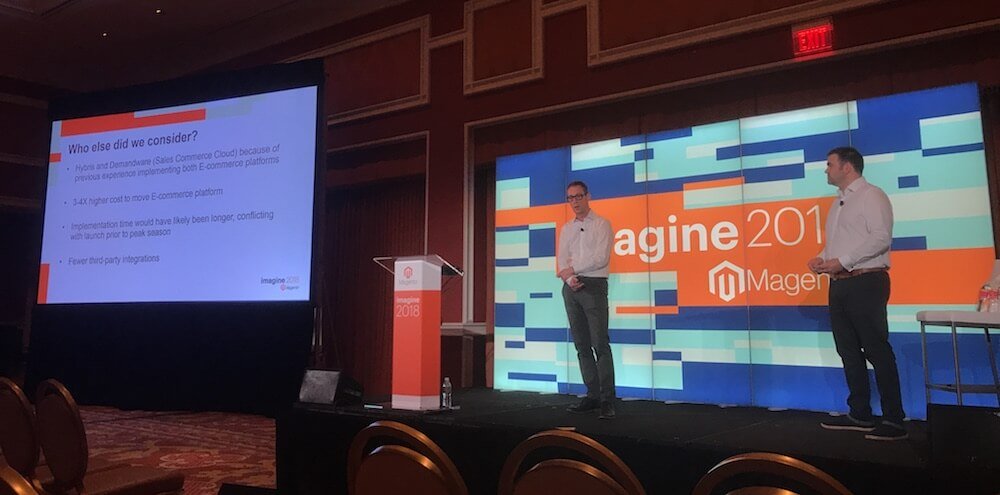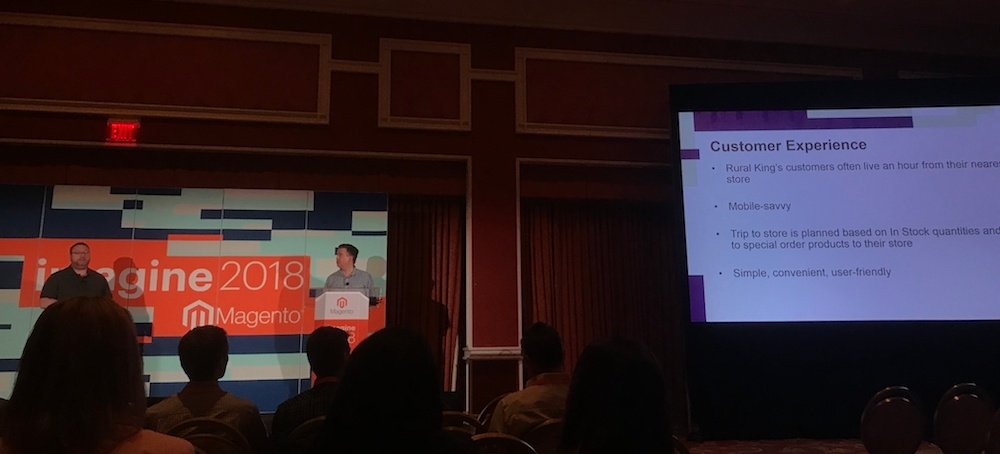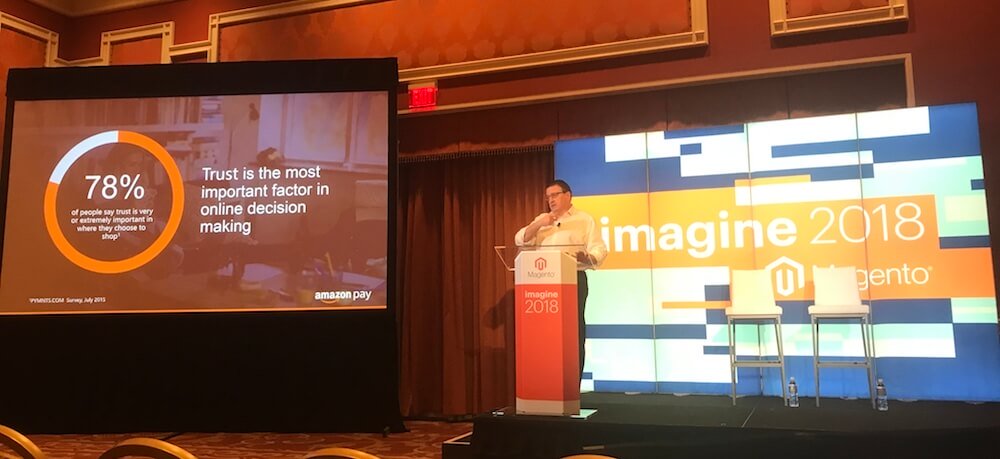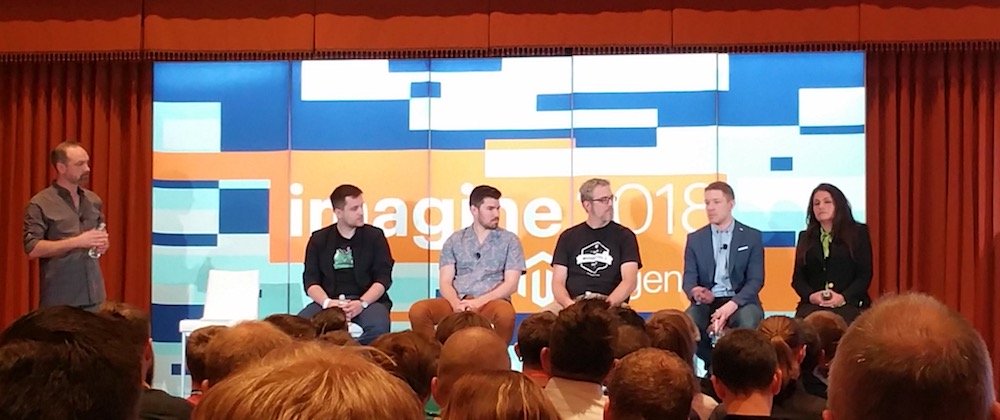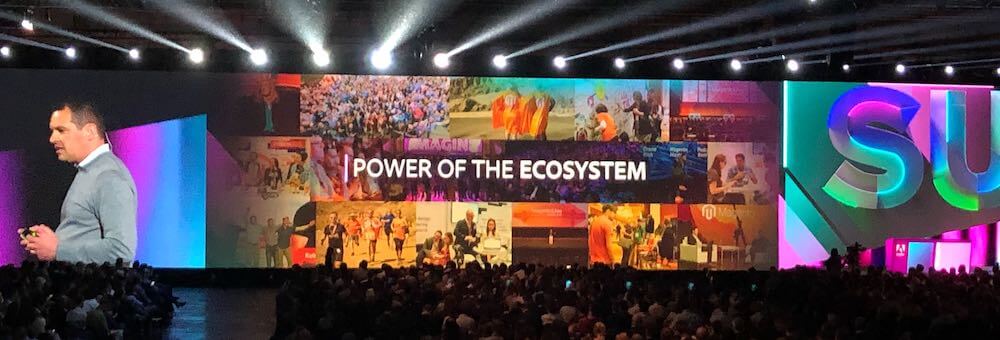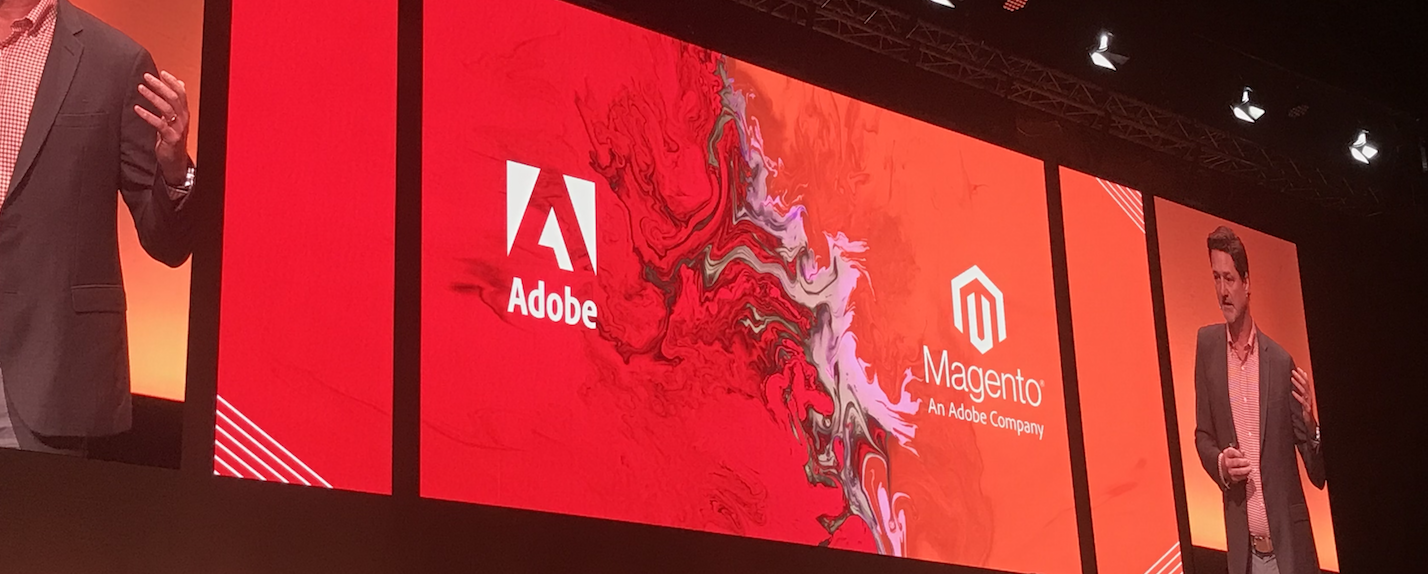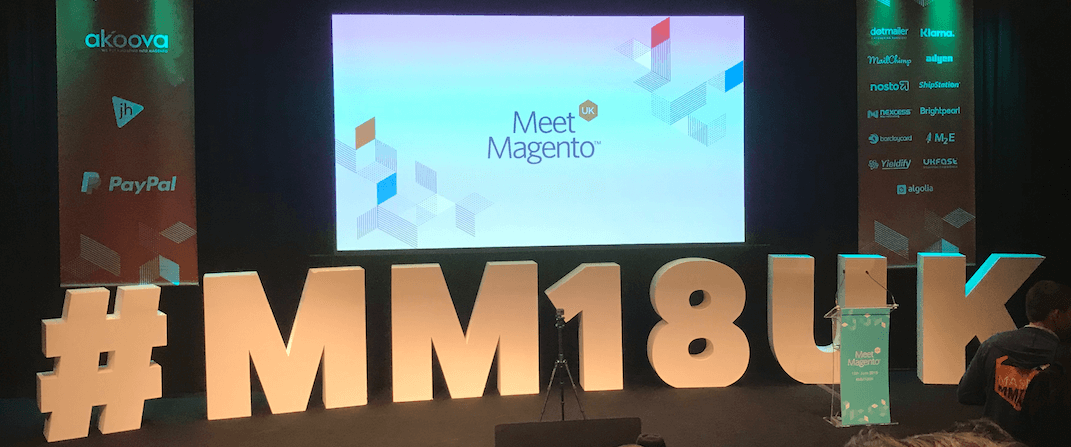What a week it was for ecommerce, as the curtain came down on the eighth edition of the Magento Imagine conference! Attendees flocked to Las Vegas in their thousands, days in advance of the event, to soak up the atmosphere.
By the first official day of the conference, Magento and AOE had already hosted a hackathon, Wagento had held a community Hoover Dam fun run (“The Big Dam Run“) and ShipperHQ had hosted the pre-imagine event. All were great opportunities to make new friends, connect with old ones and commence knowledge swapping!
Overview of Magento Imagine 2018
This year’s conference was the largest ever, with three days of content covering a wide-range of tracks, including B2B, Growth Strategies, Small Business, Commerce Best Practices and Technical.
Having now been to six Imagine conferences, I can say that the feeling from the community, as well as Magento’s position in the market, has never been stronger. While the Magento 2.0 release came with its pains, the entire ecosystem has clearly moved past that. With the stabilisation and some huge new features and developments in Magento, it’s a very exciting time.
For those keeping abreast of Magento news, there arguably wasn’t much in the way of surprise announcements from Magento themselves. Instead, they offered a consistent message that shows how Magento’s continued investments over recent years are creating an incredibly strong market position for them. In addition to the core Commerce product, Magento has Cloud, Business Intelligence, Shipping, Order Management and Social that sit nicely together. Then, within the Commerce platform, there’s the significant addition of comprehensive B2B features over the last year as well as brand new features of Page Builder for revolutionised content management and the imminent PWA Studio project.
Add to this, their partnerships with key solution providers which include baking functionality into the core that enables lightning fast on-boarding to services such as Amazon Pay and Vertex. It’s easy to see where all the excitement is coming from. Indeed, Amazon has a whole suite of innovations that they use to power their own business growth and make available for merchants.
Amazon’s latest Magento-specific announcements are the official Magento integrations that are now available for Amazon Marketplace and Amazon Fulfilment.
All of this directly translates into success and incredible return on investment for merchants over the lifetime of their Magento implementation. I can see why Magento considers itself the last ecommerce platform you’ll ever need!
There were a few standout merchants invited to the stage to share how they’ve grown on the power of the Magento ecosystem and are providing great customer experiences. These included Universal Music Group, Baked by Melissa and the Pittsburgh Steelers! The consistent message that I received by each is that Magento is a platform that enables.
It’s long been recognised that the community is one of Magento’s strongest assets and it reaffirmed its commitment to supporting this by announcing a new collaboration with what previously had been the Meet Magento Association. An organisation that has held Magento-focused events in countries all over the world will now be known as the Magento Association and will work more closely with the core team.
There was more evidence of the strength of the community when it was announced that more code contributions have been accepted into the Magento core than in any other PHP platform.
These contributions have been widespread over different features and bug fixes but certainly one project of note is that of adding “Multi-source inventory” to Magento. It’s a project that’s been undertaken by developers from agencies all over the world that have been supported by Magento’s Community Engineering team and is finally close to fruition.
This is one of many features that will be coming out as part of Magento 2.3 and 2.4. Others include GraphQL support, bulk asynchronous APIs and a declarative database schema. Find out more from John Hughes Twitter coverage of the What’s in Magento 2.3 breakout session.
Before I move on to summarising some of the breakout sessions, I’d be remiss if I didn’t thank Magento for including me in this year’s list of Magento Masters. I’m proud to have been able to contribute in the last year through supporting people on the Magento forums, as well as sharing my knowledge of cognitive commerce and progressive web apps at conferences over the last year. It means a lot to be included with so many fantastic people from our community. There are so many more that deserve it too, so best of luck to them next year!
Breakout Sessions
In addition to the general sessions, where we can get a feel for the direction of Magento (upwards!), the breakout sessions always provide a wealth of knowledge from merchants, agencies and technology partners that are working in the trenches and surface at Imagine to share their learnings for us all to benefit from.
This year, we were lucky enough to send a team of people to Imagine, so we’ve been able to come back with notes and highlights to help you keep abreast of the latest developments in Magento and ecommerce best practices. So please, read on to find a selection of our key takeaways. To find out more, many of the presentation slides are available on the Imagine site.
PWA Studio Initiative
It’s been made clear over the last year that the PWA Studio project is a key part of the product roadmap for Magento. One that puts it ahead of the market when compared to the other serious ecommerce platforms. With that, one of the very first breakout sessions for the day was from James Zetlen, the lead frontend architect at Magento.
James took us though a tour of the history of the web and how we’ve achieved some great experiences, but that mostly these have been paper castles. Grand displays that were ultimately limited by the underlying functionality of web technologies. This gave the app industry the opportunity to rise up because being native gave them the features and the control to create better customer experiences.
Progressive Web Apps is the marketing term for the latest web technologies that are being developed by browsers to try and change that. The web already benefits from superior platform compatibility and distribution, now it can also benefit from:
- Advanced control of storage on the device.
- Control of request flow which together with the storage improvements means that we can reduce our dependency on having an reliable internet connection.
- Ability to run processes in the background, including push notifications.
As with many new technologies, PWA raises the bar on the potential customer experience that can be achieved but this comes with new and additional technical complexity. We now need to consider app shells (the minimum that is shown without an internet connection), service workers and maintaining and synchronising local data.
We heard that this project is going to be on a separate release cycle to the rest of Magento. The progress will be routinely published to a new Magento Research github page. This is great and almost imperative for a technology that’s moving at a much faster pace than the rest of the web.
The guiding principles of this team seem slightly different to previous Magento projects, with a real focus being given to developer experience and not reinventing the wheel. Even for things that do need to be created, they’re looking to build in a generic way which can be contributed back to other open source communities. This is a first for Magento, as far as I’m aware, and a maturing commitment to open-source.
While it’s not the core deliverable of the project, Magento developers have been working on a demo theme, called Venia, to show off what can be achieved with PWA studio. However, the product really is a collection of building blocks that can be composed together to create a performant theme rather than the historical approach of building on top of a large base theme.
Compared to other Magento PWA projects going on out there, Magento has the most difficult task of defining the standards for a new technology and architecture, e.g. that supports the extension marketplace, but that also makes it the most exciting!
View the slides from the PWA session.
Baker Distributing B2B Migration
Baker Distributing is part of the Watsco group and specialise in providing heating, air conditioning and commercial refrigerating equipment. As a team, they presented their approach to migrating from Magento 1 to Magento 2 and how they made use some of the newest B2B features of the 2.2 Magento, including negotiable quotes. While they may not have used all of the features of the B2B release, the modularity of Magento enabled them to pick the ones that suited their business and provided a firm foundation for building the custom functionality on top.
For me, the most inspiring takeaway from this talk was the value that they put on “internal open source”. They are part of a large group of companies and it would be easy to continue working as separate entities and development teams. What they do instead is make sure that their code is reusable and published internally for other teams to build on top of and contribute back to. This generates far more value and cost-effectiveness for the business as a whole.
While it was painful to move away from Magento 1, because they had built up a bank of trusted extensions and custom functionality, they felt that moving to Magento 2 was necessary in order to benefit from all of the latest work from Magento and the wider community.
One of team’s most surprising discoveries was that the demographics of the typical B2B customer did not meet the stereotype of a middle-aged man in a suit but instead there was a significant portion of younger female buyers. Either way, what they found to be important to improve conversions was not necessarily working on the emotional piece that would traditionally be the approach in B2C but instead focusing efforts on facilitating quick and effective decision-making by providing product information clearly.
View the slides from the B2B Migration session.
Cox & Cox
We were proud to have our client, Cox & Cox, share their Magento migration experience with the Imagine audience. Jake Smith, our Senior Project Manager was also on hand to go through it from our perspective. To top off our time at Imagine, Space 48 and Cox & Cox won the award for Best Magento Upgrade! It’s safe to say we’re extremely proud of our team and love working with clients such as Cox & Cox.
Cox & Cox is a pure-play ecommerce homeware company which had been stuck on Magento 1.7 without the ability to upgrade to newer versions of Magento 1.X due to technical debt. We took on the site to get them to a better place on Magento 1 and then helped prepare a long-term strategy, which included a migration to Magento 2.
There were clear objectives and benefits of migrating to Magento 2:
- Add a mobile-first responsive design
- Stay closer to native Magento by reducuding the number of extensions used to improve maintainability and upgradability
- Build reliable foundation to future-proof for business change.
- Sustain 20% year-on-year revenue growth
While the brand did consider other platforms, such as Hybris and Demandware, these were going to be three to four times more expensive and have a longer implementation time, so Magento 2 was clearly the best option.
Some of the key benefits of the new platform included:
- Integrating SLI for search which now powers 35% of revenue
- Operational efficiencies from features like visual merchandising and easier content management and scheduling
- Pre-sell functionality to take orders for items that need to be manufactured
- Complex shipping requirements made simple with Magento Shipping
In terms of tips for approaching such a large project, the speakers recommended:
- Working with an agency you trust
- Regular internal releases to staging (enabling regular testing rather than all of it needing to be done at the end of the process)
- Getting key integrations done early
- Planning well in advance and not underestimating complexity
- Focusing on collaboration and empowering the merchant
The proof was in the pudding as in Q4 last year, Cox & Cox saw the following results:
- 28.8% increase in revenue rising to 45% on mobile
- 6.7% increase in conversion rate, rising to 20% on mobile
- 26% increase in average order value
View the slides from Cox & Cox’s session.
Radical Change at Rural King
Rural King is a farm-supply store with over 110 stores in 13 states. It was immediately clear that the brand had a great ethos that prioritises the needs of putting customers first.
Partnering with their agency, Creatuity, the team built a new platform with key technologies of Magento Commerce Cloud, Magento Order Management and Logicbroker, that radically changed their business. This enabled them to move from a predominantly paper-based business to one where drop-shipped orders have a 100% automated fulfilment process.
They spent time understanding their customer-base and found that many lived over an hour away from a store. With this understanding, the business added the ability for customers to check in-store stock so that they could plan their trip and even order products to the store, to avoid disappointment.
To reduce the time spent by customer service on repetitive tasks, they ensured that the order status was synchronised so that customers could self-service. This enabled customer service representatives to focus on the requests that really needed their attention.
From a technical perspective, Joshua from Creatuity shared one the reasons behind Rural King’s technology choices. The main one being that Magento Order Management has a lot of functionality out of the box for managing the process without needing to worry about building any integrations into Magento, so they could get up and running quickly.
Using another Magento product, Business Intelligence, they benefitted for the same reason. As they’d migrated old orders into the new platform, the connection to Business Intelligence automatically picked these up. While this might not have been planned, it meant that Rural King was able to create and review reports from day one, comparing to data from years prior.
View the slides from Rural King’s session.
Mobile & Millennials – Payments Best Practices for 2018 and Beyond
Looking at how younger generations are checking out on ecommerce websites is key to understanding where the market is going. As we have seen over the last few years, speeding up and streamlining customer checkout is key for mobile conversion.
Depending on the product vertical, it’s wise to review opportunities for subscription payments, as this can sustain growth and is a payment plan that millennials are comfortable with.
Another suggestion was to consider the use of SMS and push notifications throughout the shopping experience, in addition to or as a replacement for emails, as they can be more effective for engagement.
Progressive Web Apps are an important part of the developing landscape for mobile. In fact, some of the newest APIs allow for making use of saved credit cards in the browser when placing an order for even faster payment processing.
In terms of B2B, our approach needs to adapt to millennial preferences. Picking up the phone to speak to suppliers is not their default communication method, so the entire purchasing experience should be very intuitive on mobile. There’s huge room for improvement here, as it’s common for key pieces of functionality not be available for customers to self-service.
View the slides from the Mobile & Millennials session.
Marketing at the Speed of eCommerce
Consumer expectations are at an all time high, which means that we continue to be challenged to do more for our customers. It’s becoming harder to meet customer expectations without personalisation. In fact, it’s quoted that $756 billion is lost by merchants due to customers going elsewhere because of lack of personalisation.
One of the biggest challenges from a marketing perspective is having a cohesive message and campaign across a wealth of channels, including the various social media platforms. It’s easy to be in a place where data is disconnected, siloed in different platforms, which results in partial views of customers and therefore sub-par recommendations and campaigns.
If we’re able to connect the data to build a single customer profile, we can better understand the customer journey and make better decisions on marketing and implement more accurate (and therefore more rewarding) personalisation.
View the slides from the Marketing at the Speed of eCommerce session.
Mapping the User’s Journey
Understanding a customer’s journey and being empathetic to their needs is the only reliable way of creating more effective designs. The two main tasks discussed to help achieve this were creating personas and then mapping user journeys.
Creating personas, or an empathy map, helps to put ourselves in a user’s shoes by thinking from their perspective and asking questions such as:
- What are they thinking and feeling?
- What are they seeing?
- What are they hearing?
- What are they saying?
With the personas, you can then move onto user journey mapping, which creates a table of steps that a user would make. For each step consider the following:
- Actions the user has to make to move to the next step
- Questions the user needs to answer before they will move to the next step
- Happy moments that improve the experience
- Pain points that spoil the experience
- Opportunities to further improve the experience
View the slides from the Mapping the User’s Journey session.
How Coyuchi launched their subscription model on Magento 2
This was another Magento 2 migration success story, this time via partnership with Atwix.
Coyuchi is a home textile company that wanted to reinvent home textile consumption so that it was circular. The business wanted to do this after finding out that 10 million tons of textile waste end up in landfills each year. What they did was launch a subscription service called Coyuchi for life, where you can receive new linen every 6, 12 or 24 months to suit you and then at the end of the cycle you can send it back for recycling.
Coyuchi launched on Magento Commerce 2.1 and capitalised on the extensions available in the marketplace. This came with its own challenges in making everyone work together in the way that they wanted. It was hard to find subscription functionality but Coyuchi eventually chose an extension from Paradox Labs, which also provided compatibility with Authorize.net CIM for collecting payments.
Building at a relatively early stage for the Magento 2 platform had its difficulties, as the team had to patch bugs in the Magento core as well as in extensions in order to progress. Once the key features and functionality were there, Coyuchi launched and moved everything else to the post-launch release cycle, including optimisations.
View the slides from Coyuchi’s session.
How Coca Cola builds customer lifetime value
It was great to see Coca Cola back again, continuing to share its story. Particularly, how it has developed since the successful launch of the “Share-a-Coke” campaign.
3 years ago, Coca Cola created an online store to enable customers to create their own personalised bottle and get it delivered. While this site was initially only for a single product, it has expanded to a wide range of clothing and accessories and nows sells over 6000 SKUs.
The brand has innovated in a number of other business areas since then. One that was shared was their mobile wallet built into the Coca Cola app that enabled vending machine transactions. Another was capitalising on the virality of a product at the Coachella music festival, by getting it ready and available to order online within 24 hours.
The speakers talked about Neverfail water which is an Australian spring water brand. They said that a key part of their success on Magento 2 has been iterating based on customer feedback. Then the challenge, as many of us will agree with, is to find a way of prioritising the list of improvements out of that. The reality of this is that they had to say no to some tasks (and internal meetings!) in order to “get shit done”.
What both companies had found was that ecommerce works much faster than their traditional business, so they had to be creative!
View the slides from Coca Cola’s CLV session.
Pioneering eCommerce: Exploring New Technologies
This talk explored a lot of the last year’s hottest buzzwords: AI, Blockchain, Internet of Things, and Natural Language Processing.
First off, they covered how AI can be used to maximise opportunities, improve competitiveness, increase agility and minimise requirements for resource.
There’s a lot of hype around AI and it’s wise to be careful around companies that capitalise on it as a buzzword in their marketing. With that said, there are still huge potential for products improve their offering with AI.
Areas that AI is improving include:
- Price management – more accurate and up-to-date tracking of production and competition pricing
- Stock management – improved forecasting models
- Workflow automation – greater ability to automate repetitive tasks and more pre-built solutions now available to do so
- Personalisation – can now model customer behaviour and intent with far higher accuracy – down to the individual person rather than just segments
Moving on, blockchain is a novel technology that facilitates transactions without the need for trusting third parties. It’s still early days for understanding all of the opportunities to apply it but it’s being considered for shipping documentation, managing the lifecycle of a product and any other logs that need verification. At this point, the best step is to learn about the concepts and then see if there’s any potential for proof of concepts, i.e. for inter-company transactions.
Next up was the Internet of Things, i.e. adding connectivity to traditional unconnected devices. This can be useful for tracking the movements of people and products, as well as monitoring the environment. This is great for being able to collect more data and operate more efficiently, but it comes with its own challenges of deploying and digesting the data in a cost-effective manner, as well as maintaining security.
Finally, there has been a lot of hype around natural language processing over the last year with implementations, such as home voice devices as well as chatbots and improved search tools. There are still huge opportunities for gains through the deployment of voice systems, like in warehouses and other situations where use of hands is limited. Like all technology deployments, there are security precautions to put in place.
Technology moves too fast to get a grasp on all of it, let alone deploy it. The summary of this talk was to do the best you can and identify opportunities to capitalise on it to gain a competitive advantage, not just in commerce but across the business.
View the slides from the Pioneering Ecommerce session.
Introducing Magento Page Builder: Powering Your Website Content, Themes and Extensions
One of the most exciting feature releases in Magento Commerce 2.3 is the Page Builder, which was borne out of the acquisition of the BlueFoot extension from Gene Commerce. The good news is that it will also be available to purchase from the Magento Marketplace for merchants on the Magento Open Source product.
Magento Page Builder enables drag and drop page layout management, which makes creating new page designs really easy without the need for a developer. Being able to create a new page of content, while also integrating the commerce components, is incredibly empowering for the merchant. The early access program starts this month, May 2018.
View the slides from the Page Builder session.
Driving More Revenue Through Content Marketing & SEO
This talk reinforced the benefits of content marketing. Creating high-value content pieces will increase the chances of external sites linking in (backlinks), when compared to category and product pages. These backlinks are still one of the most important ranking factors for a website, which is why it’s so important. Having this valuable content, whether on your own site or on a third party, is also advantageous because this is what customers are more likely to come across during their research phase and then they’ll be directed to the brand site.
When investing in content marketing, it’s good to have a plan. This will include content guidelines for your brand and a content calendar to plan when you’ll be writing and releasing articles. It’s advised to do content and keyword research to identify the best opportunities for content, so that you can take a targeted approach and invest in each article, making sure it’s high quality.
There aren’t quick wins with this approach and it will take months and years of concerted effort but the returns will come – just ensure you’re measuring your KPIs effectively to track progress and adjust as necessary!
View the slides from the content marketing and SEO session.
Connected Commerce
This was one of a few sessions from Amazon, who had a large presence at Magento Imagine this year. We were introduced to the Alexa and Pay team and how they’re working together to revolutionise commerce.
No one wakes up and says they want to pay for something, they want to buy something. With 62% of US consumers having connected devices outside of mobiles and tablets, there’s a huge opportunity to provide frictionless payments and commerce.
AI-powered voice devices are the focus of our attention right now because they provide a new user interface that changes the way we can engage with customers. An example given was that while most systems provide a customer account area to log in to find your order status, this normally is too much friction for customers to actually perform. Devices like Alexa provide this helpful functionality without even needing to change what you’re doing, which means this kind of feature (and more features that we haven’t thought of yet) will become more commonly used.
This is a big change in the way that customers engage with brands, because much of the time this involves inviting the brand into their lives and homes, which is statement of trust.
This foundation of trust is key to success in voice commerce and commerce in general. Surveys have revealed that people think trust is the most important reason why they buy from a merchant, not price!
We know that not all ecommerce actions suit voice though. The use cases that best migrate to voice right now are “additions” to a pre-existing engagement, such as re-ordering, checking order status or adding items or upgrades to an order. You can even make use of Alexa notifications to send push messages to a customer’s device once an action has been completed, if it’s going to take a while.
One of the advantages of the Amazon ecosystem with Alexa and Pay is that merchants will benefit from all of the technologies that Amazon themselves use, e.g. fraud detection. One of other benefits is that Amazon knows the email address of the Alexa user and so can provide it as a way of authenticating them without the need for account linking (forcing the customer to log in first).
Ultimately, this technology and its usage is at such an early stage of its lifecycle it’s hard to know quite how it’s going to be used, as it matures and more use cases are found. What’s clear, is that there’s a lot of potential! One of the most successful Alexa skills right now in the Donation skill that means you can send money to charities.
View the slides from the Connect Commerce session.
“Alexa, Order Me a…”
The next Amazon session was much more focused on the design and implementation of an Alexa skill. When a new interface comes around, such as voice, we often try and apply old paradigms to it. After a while, we then find unique ways of embracing it – we’re still very much in that stage. However, we do know that voice is the future of commerce for the connected consumer.
Like any system, it’s recommended to take some time in advance to design it. For voice technology, it’s useful to create scripts to imagine the different scenarios that a customer may go through. Don’t just think about the happy path, as a user will surprise you!
When creating responses, we’re advised to keep interactions brief and guide the user to make it easy for them to succeed. For example, don’t give more than three options at once and ask for information one piece at a time.
For purchase authentication, you can enable a form of PIN code but, in time, Amazon expects to be able to authenticate via voice recognition alone, as they can already fairly accurately detect who in the household is talking to the device.
Ultimately, we’re getting to the point where you can purchase with a “yes” – how simple!
View the slides from the Amazon “Alexa” session.
Getting Ahead with the Progressive Web
On the final day of the Imagine conference, I was proud to be invited to take part in a panel discussion on PWA. There were a broad range of experiences on the panel, from those that were researching and preparing for PWA but didn’t believe it was the right time to commit to those that had built on headless platforms that enable it, essentially replacing the Magento frontend.
It was agreed that, in time, PWA will become standard practice. So, if you’re planning on a site implementation in 2018, it has to be considered. The simplest description of progressive web app was that it was a marketing term representing the pinnacle of what can be achieved with the latest web technologies, which includes being able to work offline in such a way that makes it feel and act more like a native mobile app.
There are other niche features that were previously only available to native apps but now are available by way of APIs in the browser, for example, push notifications and geolocation.
At the same time, there’s a natural movement towards “headless” single-page applications (where the page never reloads and instead dynamically updates page content), because this supports the PWA very well. This is positive news for frontend developers, particularly within the Magento ecosystem, because it means that they have more freedom to focus on their implementation and not be blocked by requiring backend Magento knowledge. From a recruitment point of view, it’ll be easier to add new frontend developers to the ecosystem without them needing large amounts of Magento training.
That being said, there is definite complexity in some of the new technologies, so until we reach a point where there’s more pre-packaged software to build on top of, it will require significant javascript knowledge with traditional software engineering principles in order to be able to excel at the more complex PWA features and implementations.
Magento’s PWA Studio is arguably the most exciting proposition but we will need to be patient for its development, which will go through gradual releases and, in time, will support contributions from the community to help it get there quicker.
View the slides from the Getting Ahead with the Progressive Web App session.
Summary
See, I wasn’t kidding. There was so much to learn at Magento Imagine, it was impossible to take in everything. Whether you could attend or not, I recommend reading through the agenda again and viewing the presentation slides of the pertinent topics for your business and keeping an eye for the recordings as they are released.
I must just say thanks to Oliver Lees, our Head of Insights, and Jake Smith, Senior Project Manager for their contributions to this post!
One more thing…it’d be rude not to congratulate our colleague, friend and Magento developer Raul Watson! He not only achieved two Magento certifications during the conference, he also got married! ???
And, finally, I’ll leave you with Imagine’s most inspiring quote:
Lead The Charge! ?♀️
Space 48 is a leading UK ecommerce consultancy, based in Manchester, specialising Magento and Shopware website development. Were you inspired by any of the sessions and ecommerce innovations discussed in this Magento Imagine highlights blog? Why not get in touch or book a free consultation with one of our Magento specialists?
{{cta(‘958954c7-8546-40b1-89bd-5cc3c978f805’)}}
